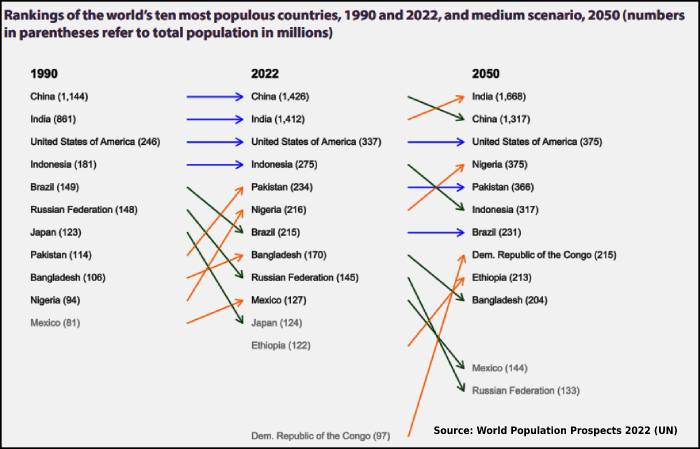
November 16 2022: The world's population is projected to have reached 8 billion people on November 15, according to the UN estimates, which consider this a milestone in human development.
The latest projections by the United Nations suggest that the global population could grow to around 8.5 billion in 2030, 9.7 billion in 2050 and 10.4 billion in 2100.
China (1.44 billion) and India (1.39 billion) remain the two most populous countries of the world, both with more than 1 billion people, representing 19 and 18 per cent of the world’s population, respectively. Around 2027, India is projected to overtake China as the world’s most populous country, while China’s population is projected to decrease by 31.4 million, or around 2.2 per cent, between 2019 and 2050.
Summary of results
The world’s population continues to grow, but the pace of growth is slowing down • The world’s population is projected to reach 8 billion on 15 November 2022.
• The latest projections by the United Nations suggest that the global population could grow to around 8.5 billion in 2030, 9.7 billion in 2050 and 10.4 billion in 2100.
• Population growth is caused in part by declining levels of mortality, as reflected in increased levels of life expectancy at birth. Globally, life expectancy reached 72.8 years in 2019, an increase of almost 9 years since 1990. Further reductions in mortality are projected to result in an average longevity of around 77.2 years globally in 2050.
• Life expectancy at birth for women in 2019 exceeded that for men by 5.4 years globally, with female and male life expectancies standing at 73.8 and 68.4, respectively. A female survival advantage is observed in all regions and countries, ranging from 7 years in Latin America and the Caribbean to 2.9 years in Australia and New Zealand.
• Following a drop in mortality, population growth continues so long as fertility remains at high levels. When fertility begins to fall, the annual rate of growth starts to drop.
• In 2021, the average fertility of the world’s population stood at 2.3 births2 per woman over a lifetime, having fallen from about 5 births per woman in 1950. Global fertility is projected to decline further to 2.1 births per woman by 2050.
• In 2020, the global population growth rate fell under 1 per cent per year for the first time since 1950. The world’s population is projected to reach a peak of around 10.4 billion people during the 2080s and to remain at that level until 2100.
• Two-thirds of the projected increase in global population through 2050 will be driven by the momentum of past growth that is embedded in the youthful age structure of the current population. Such growth would occur even if childbearing in today’s high-fertility countries were to fall immediately to around two births per woman.
• Given that most population increase until 2050 will be driven by the momentum of past growth, further actions by Governments aimed at reducing fertility would do little to slow the pace of growth between now and midcentury, beyond the gradual slowdown indicated by the projections presented here. Nevertheless, the cumulative impact of such changes could contribute to a more substantial reduction of global population growth in the second half of the century.
• Sustained high fertility and rapid population growth present challenges to the achievement of sustainable development. The necessity of educating growing numbers of children and young people, for example, draws resources away from efforts to improve the quality of education.
• For countries with continuing high levels of fertility, achieving the Sustainable Development Goals (SDGs), particularly those related to health, education and gender, is likely to hasten the transition towards lower fertility and slower population growth. Rates of population growth vary significantly across countries and regions
• In 2022, the two most populous regions were both in Asia: Eastern and South-Eastern Asia with 2.3 billion people (29 per cent of the global population), and Central and Southern Asia with 2.1 billion (26 per cent). China and India, with more than 1.4 billion each, accounted for most of the population in these two regions.
• More than half of the projected increase in global population up to 2050 will be concentrated in just eight countries: the Democratic Republic of the Congo, Egypt, Ethiopia, India, Nigeria, Pakistan, the Philippines and the United Republic of Tanzania. Disparate growth rates among the world’s largest countries will re-order their ranking by size.
• India is projected to surpass China as the world’s most populous country during 2023.
• Countries of sub-Saharan Africa are expected to continue growing
World Population Prospects 2022
Ten Key Messages